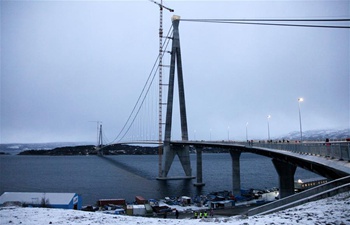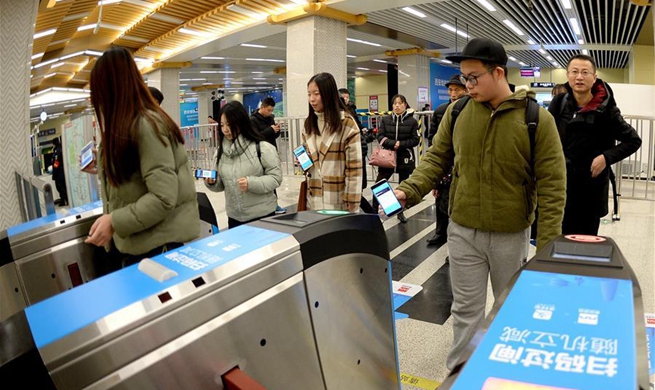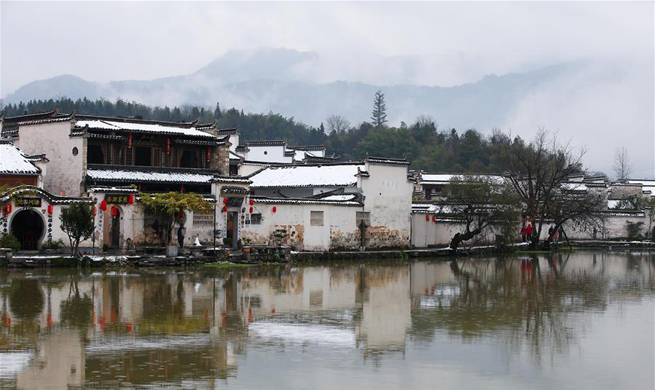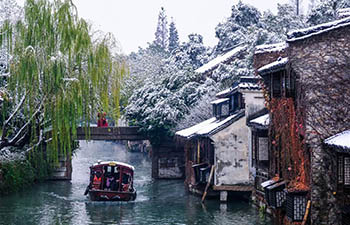by Roisin Timmins
NANNING, Dec. 10 (Xinhua) -- The plane descended through what felt like miles of clouds before they came into view: The unmistakable karst peaks of Guangxi Zhuang Autonomous Region, in south China. An altar at which artists have worshiped for centuries, as the hundreds of rivers and tributaries that weave through the region have carved spectacular limestone mounds that jut impossibly from flat flood plains.
It's no surprise that the makers of the Star Wars films chose this place for sets, it looks like another planet. It looks like giants have sown obelisks in flat land. It looks like aliens have used lasers to carve a message for the ancient humans that have been living here for millennia.
ANCIENT TRADITIONS, MODERN LIVING
There's evidence of Zhuang settlements in Guangxi going back 2,500 years and today they are the largest ethnic minority group in China. Once thought of as a somewhat reclusive culture -- their villages being inaccessibly deep in the mountains -- they are actually one of the best integrated of China's 55 ethnic minorities.
In Dawu village, close to the region's capital, Nanning, 94-year-old Daeng Gwzginz sits patiently in the chilly, late afternoon drizzle. His mandarin is good enough to assure me he's not at all cold, and ask if I've eaten, but when asked to describe his life he switches into the stop-start sing-song of his mother tongue.
The Zhuang dialect is closer to Thai or Vietnamese than standard Chinese, but also extremely varied: another Zhuang from a different village would probably have difficulty understanding him. So via a translator native to Dawu, Daeng told the story of growing up in Guangxi at the beginning of the last century.
"In the past, we had only corn and cassava," he said, clasping his liver-spotted hands on his knee, "Rice was only for festivals."
The farmer's life was hard when Daeng was young. He kept cattle and worked the land, eking out a living. But as he entered his golden years, things began to look up. He attributes the dramatic improvements in his life to reform and opening up, which began in 1978.
"Now that old kind of life is gone," he explains simply. "Now we can eat porridge, rice or whatever we like. As for the clothes, I can buy what I see fit."
Zhuang people like Daeng were isolated by their language. He has never been further than Nanning, just a short drive from his village. So, language education was one of the first priorities for the local government if minorities were to prosper.
As of this year, Mandarin is spoken by about 85 percent of Guangxi's population. There are still 3.4 million Zhuang people who cannot speak Mandarin Chinese but most of the younger people do. This means they can go and work and in other parts of the region. That often means catering for the millions of tourists that arrive each year.
ADVENTUROUS ATTITUDES IN YANGSHUO
In 1973, Guilin was one of the first Chinese cities to open its splendor to foreign tourists. As a result, the city's tourism industry feels very established. In a particularly beautiful corner lies a hot spot for tourists wanting to get out and explore the incredible natural surroundings: Yangshuo.
Unlike the aggressive, fire-breathing dragon of European folklore, the Chinese dragon is more closely associated with water. And chugging on the Lijiang River in a little boat feels like entering the mouth of the beast. Karst teeth reach out towards the sky as misty clouds swirl around like breath. This is a land for adventurers.
One of those adventurers, Andrew Hadesh, has literally written the book on Yangshuo's rock climbing scene. The hefty, Lonely Planet-esque tome is filled with guides to the best climbing -- and socializing -- spots. "Yangshuo is the base for outdoor sports in China," he explains. "Here it's kind of been organically grown. The people that come here to participate in the sports are the ones developing the sports."
And that makes for a truly unique sporting community. "There's English, there's Australian, there's Chinese, there's Japanese, there's Thai. They all come here and we work together and we share the same experiences," Hadesh says with a grin. "There's not many places in the world that you can find this."
According to Hadesh, this "melting pot of love" in Yangshuo has become a destination for more people as Guangxi's infrastructure has improved. "The things that the government has done to increase the ease of traveling to Yangshuo and the appeal of Yangshuo ... it's been amazing," he says. "And the foreign traffic has increased dramatically in the past 10 years."
This increase in foreign traffic directly benefits the local economy. Last year, Guilin welcomed more than 82 million tourists, who spent 97 billion yuan (about 14 billion U.S. dollars). And, with a new high-speed train station in Guilin bringing the total to nine stations in this city alone, the tourism industry looks set to continue growing.
But better infrastructure doesn't just benefit tourists. In fact, the key beneficiaries from better roads and railways are traders looking to take advantage of Guangxi's key position on China's border with Vietnam.
BEYOND TOURISM: EXPANDING INDUSTRY
In the Guangxi-Pingxiang Integrated Free Trade Zone, Vietnamese and Chinese writing is jumbled together on signs and labels everywhere, especially at the logistics park, where mountains tower over stacks of cargo. Trucks lumber through constantly, piling up at the border crossing.
Zipping around the trucks and tourists are dozens of scooters, one of them belonging to Nong Tuan, an agent who coordinates between companies and customs. "It's good here, business is hot," he says enthusiastically. "There are so many people coming and going."
Every day Tuan makes dozens of trips between his native Vietnam and China. "Sometimes I need to charge my scooter twice a day," he says.
The free trade zone covers areas on both sides of the Sino-Vietnamese border, at Pingxiang and Dong Dang, respectively. Besides facilitating bilateral ties between China and Vietnam, Pingxiang is also a part of the Beibu Gulf Economic Zone along with five other cities that, as part of the Belt and Road Initiative, provide a gateway to ASEAN countries.
On an even grander scale, goods arriving in Guangxi's ports from Singapore could end up in as far away as Germany on the epic Singapore-Qinzhou-Chongqing-Xinjiang-Europe sea and rail link. This makes Guangxi a strategic centerpiece to both the Silk Road Economic Belt to the north and the Maritime Silk Road to the south.
NEW NETWORKS FOR A NEW ERA
Over the past 60 years in Guangxi, roads and railways have connected mountain-dwellers to seafarers, allowing people, goods, and ideas to flow as freely as its many rivers. The landscape, timeless as it is, has remained relatively unchanged, but opening up has brought so many changes to the lives of the people who live here.
The most obvious is the hugely profitable tourist industry and the amazing memories that visitors take home with them, but the most important has been the impact on the Zhuang. Star Wars may seem like a fantastical imagining of the future to us, but it's no more far-fetched than modern-day Guangxi would have seemed to a young Daeng Gwzginz, dreaming of rice bowls in the tiny village he had no hope of leaving.
With the language barrier torn down, the young Zhuang of Dawu come and go as they please through this once remote and reclusive region, blossoming into a super-connected international hub. This is no science fiction. Opening up has transformed Guangxi, and it's taken less than a lifetime for Star Wars to become a reality for its people.

















